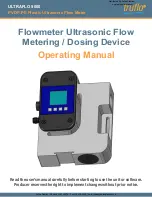
E N G L I S H
47
and connections before replacing the
solenoid.
RED (+)
SOLENOID
STARTER
MOTOR
BLACK (+)
NOTE: Repeat this test when the engine is
thoroughly warmed up. Heat expansion of
metal may cause voltage drop to increase.
Starter Motor Current Test
The battery tests and the voltage drop
tests have verified that there is adequate
battery voltage at the starter. Next,
investigate how much current the starter
is drawing by using a DC clamp-on current
probe. Under normal operating conditions,
with an outside air temperature of 70°F,
a good rule of thumb for calculating
cranking current is 1A per CID (Cubic Inch
Displacement) or 60A per liter ± about 10%.
Check the manufacturer’s specifications for
the correct starter cranking current.
To measure start current:
• Set the rotary switch to the millivolts DC
( ) setting.
• Connect a DC clamp-on current probe to
the Meter.
• Let this current probe clamp around the
positive (+) terminal cable of the starter
motor.
STARTER
MOTOR
NOTE: Make sure the arrow on the clamp is
pointed in the direction of the current flow
in the cable.
Disable the ignition so the engine doesn’t
start and crank the engine for 4 ~ 5
seconds.
Si el motor de la marcha se vuelve lento,
la corriente atraída no es alta y la batería
está en buenas condiciones, verifique la
resistencia (o caída de voltaje) en el circuito
de la marcha otra vez.
If the starter turns the engine slowly, the
current draw is not high, and the battery is
in good condition, check the resistance (or
voltage drop) in the starter circuit again.
Charging System Tests
Charging system problems often are
identified with a No-Start complaint.
The battery will have discharged and the
starter won’t crank the engine. To properly
check the charging system, the battery
must be fully be fully charged.
Summary of Contents for UD226
Page 29: ......










































